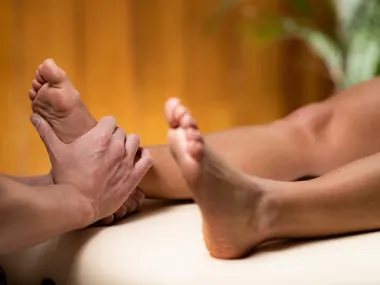
Reflexology is a specialized therapeutic technique that applies pressure to mapped zones of the feet, believed to correspond with different internal organs and systems. Unlike general foot massages, reflexology massage feet therapy uses detailed knowledge from a reflexology chart or foot reflexology map chart to guide treatment. These charts help practitioners locate reflex points to stimulate healing, improve circulation, and rebalance energy throughout the body.
Sessions typically focus on the soles, heels, arches, and toes, each of which is linked to distinct body systems. Through consistent pressure techniques, reflexologists can support relaxation, pain relief, and systemic balance.
How Reflexology Massage Works
The practice is grounded in the concept that the body is divided into ten vertical zones. Each zone corresponds to specific organs, and these zones are mirrored on the feet. A reflexology diagram of foot or reflexology chart for feet serves as a reference during therapy.
A session usually involves:
- Cleaning and preparing the feet
- Using the thumbs and fingers to apply pressure in circular or linear motion
- Targeting specific zones for focused concerns (e.g., liver, sinuses, spine)
This non-invasive technique activates the parasympathetic nervous system, encouraging deep relaxation and helping the body restore itself naturally.
Benefits of Reflexology Massage
Boosts Circulation and Lymphatic Flow
Stimulation of the foot's reflex points improves blood flow, enabling better nutrient and oxygen delivery.
Relieves Stress and Tension
Targeted touch helps calm the nervous system, reduce cortisol levels, and ease physical tightness.
Encourages Detoxification
Reflexology supports lymphatic movement, helping eliminate waste and rebalance fluids.
Enhances Sleep Quality
Clients often report falling asleep during or after sessions, thanks to nervous system regulation.
Supports Chronic Condition Relief
May help with migraines, digestive disorders, hormonal imbalance, and musculoskeletal pain.
Who Should Try Reflexology?
This therapy is ideal for:
- Clients dealing with stress, anxiety, or sleep issues
- Individuals with circulatory or hormonal imbalances
- People managing chronic pain or fatigue
- Anyone seeking holistic, drug-free relief
If you've ever searched for reflexology near me, you're likely already in need of its benefits.
The Science Behind Foot Maps and Zones
Practitioners use tools like a foot reflexology map chart or a reflexology chart of the feet to locate pressure zones.
Key relationships include:
- Toes = brain and head
- Ball of the foot = lungs and heart
- Arch = stomach, pancreas, and intestines
- Heel = lower back, sciatic nerve, and pelvis
These mappings provide a blueprint to guide sessions and deliver targeted care.
What to Expect During a Session
Before Your Appointment
- Wear loose clothing
- Drink water before and after
- Communicate specific concerns or symptoms
During the Massage
- You'll remain clothed, with only shoes/socks removed
- The session is done in a reclining or seated position
- Pressure is applied with thumbs, fingers, or knuckles
- Use of lotion or balm is optional
After the Session
- You may feel lightness or emotional release
- Mild fatigue or thirst is normal
- Drink water and rest as needed
FAQ
Is reflexology painful?
No. Some zones may be sensitive, but overall the experience is relaxing. Discomfort indicates imbalance and guides the therapist.
How long is a session?
Most sessions last 30–60 minutes, depending on your needs and areas of focus.
Can I do reflexology at home?
Yes, but working with a trained professional using a reflexology diagram of foot ensures accuracy and effectiveness.
How many sessions will I need?
Weekly sessions are common for chronic issues. For maintenance, once every two to three weeks is effective.
Final Thought: Empowering Healing From the Ground Up
Reflexology is more than a foot massage — it's a mapped journey toward balance, awareness, and relief. Using scientifically structured reflexology chart feet systems, therapists guide the body toward its own healing potential.
Ready to try it for yourself? Book a safe, professional session through trusted platforms like GayMassages.com and experience how a simple touch on your feet can transform your entire body.